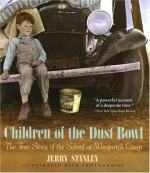|
This section contains 608 words (approx. 2 pages at 400 words per page) |

|
Children of the Dust Bowl: The True Story of the School at Weedpatch Camp Summary & Study Guide Description
Children of the Dust Bowl: The True Story of the School at Weedpatch Camp Summary & Study Guide includes comprehensive information and analysis to help you understand the book. This study guide contains the following sections:
This detailed literature summary also contains Topics for Discussion and a Free Quiz on Children of the Dust Bowl: The True Story of the School at Weedpatch Camp by Jerry Stanley.
Children of the Dust Bowl, The True Story of the School at Weedpatch Camp, by Jerry Stanley, illustrated with actual photographs from the era, is the story of the migration of Okies from the Oklahoma Panhandle to the land of promises in California. The wicked weather and winds that cursed the Oklahoma Panhandle became unbearable in the late 1930s. From 1931 through 1936, it had rained only a handful of times.
The large majority of Okies in that region were farmers whose livelihood and their very survival depended on rain. The farmers tried to hold on, praying for the day when the rains would come. But things grew even worse when unrelenting winds, sometimes at 50 MPH, became everyday events. The winds whipped up the dry earth, creating a sky constantly filled with the dust of the red clay. The region became known as the "Dust Bowl". The strife of the Okies was the subject of John Steinbeck's famous bestseller, "The Grapes of Wrath".
Unable to sustain themselves in their homeland, the people were lured to California by promises of jobs and the good life. It was rumored that no one ever got sick in California and there was food and jobs enough for all. The Okies sold most of their possessions, bought old jalopies and piled their families in the cars and took of on what was, at times, a journey of uncertainty and peril and near starvation. When the families arrived in California, they were met with signs that told them that there were no jobs available—in fact there were ten men for every job—and to keep moving on.
The people had no options—they didn't have enough money or any reason to return home. Most stayed and worked when they could and just barely made it. They lived in cardboard shacks, under bridges or set up in dry river beds. The lack of nourishing food and the unsanitary conditions brought on illness and death. Local Californians resented their presence—suspecting that they'd take jobs from them and that their taxes were being used to support them. The Okies who felt the greatest sting from the ridicule and ostracization were the children.
Leo Hart, an educator and counselor, recognized the strife that the Okie children were under and understood that though most of the children were illiterate and lacked many social skills, they were fundamentally ordinary children who just needed the chance to shine and let their talents and value show through. Hart set about establishing the Weedpatch School, which was built just for the Okie children. There were just fifty Okie kids who would be the school's first students. These kids, the teachers that Hart recruited and Hart himself built the school brick by brick. He furnished and supplied the school by seeking donations and using every free or used item he could put his hands on. The kids loved the school, and it was quickly apparent that being treated with dignity and respect had a very positive effect on them. Finally, the kids were the focus of attention and were told daily that they were important and that they could accomplish their dreams.
The school, which was classified as an emergency school, was closed after five years by state statute. However, the good that it had done was apparent in the successes that the Okie kids enjoyed as adults. Many became teachers themselves, business owners, police officers—capable and proud people who benefited from a kind man who saw the true value in a bunch of poor, rag-tag kids who most people didn't even want around.
Read more from the Study Guide
|
This section contains 608 words (approx. 2 pages at 400 words per page) |

|



